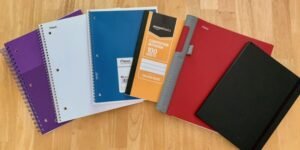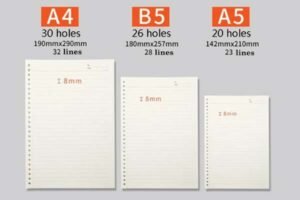
Ever stared at a stack of old composition notebooks, wondering if they're just trash? It feels wasteful, right? Good news: many parts can be recycled, but there's a little prep work involved.
Yes, you can recycle composition notebooks1. The paper pages are usually fine for recycling bins once separated. However, you'll need to remove any non-paper elements like plastic-coated covers or thick glue bindings first.
The main part of your composition notebook – the paper pages – is generally recyclable. Paper mills love clean paper fibers. But, composition notebooks often have sturdy covers and bindings that aren't always made of pure paper. These other materials can cause problems in the paper recycling process. So, a little bit of separation is key. Think of it like sorting your plastics and glass; paper needs similar attention for effective recycling.
Most composition book covers are made of thick cardboard. If it's just plain cardboard, it can usually be recycled along with the paper. However, some covers have a glossy plastic lamination. This plastic layer needs to be torn off if possible. If it can't be separated, that cover part might have to go in the trash. The glue or stitching in the spine is usually not a major issue for recyclers in small amounts, but if it's a very thick, rubbery glue, removing the bulk of it is a good idea.
Can you recycle notebooks with wire?
Spiral-bound notebooks are super convenient, but that metal wire raises a common question: does it complicate recycling? It's a valid concern for anyone trying to be eco-conscious.
Yes, you can recycle notebooks with wire, but it's crucial to remove the metal spiral2 first. The paper pages can then be recycled, and the metal wire can often be recycled separately as scrap metal.

Why Does the Wire Need to Be Removed?
Metal wire is a big problem for paper recycling facilities. When paper goes through the pulping process, it's mixed with water and chemicals to break down the fibers. Metal wires can:
- Damage expensive machinery at the recycling plant.
- Contaminate the paper pulp, leading to lower quality recycled paper.
- Cause disruptions in the recycling process.
So, recycling centers almost always require you to remove the wire before putting the paper in the bin.
How to Easily Remove the Spiral Wire
Removing the wire might seem tricky, but it's usually pretty straightforward.
- Unbend the End: Find one end of the wire spiral. Usually, it's bent inwards to stop pages from falling out. Use pliers (or sometimes just your fingers) to unbend this end so it's straight.
- Twist it Out: Once unbent, you can simply twist the wire, like unscrewing a cork. It should spin out of the holes quite easily.
- Collect Wires: If you have many notebooks, collect the metal wires. You can then take them to a scrap metal recycler or check if your local curbside program accepts them bundled together.
What About Other Notebook Components?
Wire-bound notebooks can also have other materials:
- Plastic Covers: Many spiral notebooks have plastic front or back covers (like polypropylene - PP). These are a bit trickier. Some municipalities accept certain types of rigid plastics, while others don't. You'll need to check your local recycling guidelines3. If in doubt, it's often better to leave it out to avoid contaminating the recycling stream. At NotebookRing®, we're exploring options like degradable PP covers to make this easier for the environment.
- Cardboard Covers: If the cover is plain cardboard (without plastic lamination), it can typically be recycled with the paper pages once the wire is removed.
- Dividers & Tabs: Plastic dividers or tabs should also be removed and checked against local guidelines. Paper-based dividers are usually fine.
Quick Guide: Recyclable vs. Check Locally
Here's a simple table to help:
| Notebook Component | Recyclable? | Notes |
|---|---|---|
| Paper Pages (uncoated) | Yes | Must be separated from wire/plastic covers. |
| Metal Spiral Wire | Yes (as scrap metal) | MUST be removed from paper. Check local scrap metal collection. |
| Cardboard Covers | Usually Yes | If not plastic-coated or heavily soiled. |
| Plastic Covers (PP etc.) | Check Locally | Varies greatly. May not be accepted in all curbside programs. |
| Laminated Covers | No | The plastic film makes paper pulping difficult. |
| Glued Spines (Books) | Paper Yes, Spine Check | Small amounts of glue are often okay; very thick glue might need removal. |
| Fabric/Leather Covers | No (as paper) | These materials cannot be recycled with paper. |
Always Check Your Local Recycling Guidelines
This is the most important tip. Recycling rules can vary a lot from one city or county to another. What's accepted in one place might not be in another. The best way to be sure is to:
- Visit your local municipality's waste management or recycling website.
- Look for a local recycling guide or search tool they might provide.
- Some communities have apps or helplines for recycling questions.
Taking a few minutes to check can make a big difference in ensuring your good intentions actually lead to successful recycling. As manufacturers, we value clear guidance, and we encourage consumers to seek it out too. Materials like the FSC™ certified paper we use (FSC-C106904) contribute to responsible sourcing, and proper end-of-life disposal complements that effort.
Why Choosing the Right Notebook Matters for Recycling
Thinking about recycling starts even before you throw a notebook away. The materials and construction of a notebook can make recycling easier or harder.
Notebooks made with easily separable, high-quality paper, and minimal non-recyclable components are best. Look for options from manufacturers who prioritize sustainable materials and design for easier end-of-life processing.

Material Mindfulness
When we at NotebookRing® develop products, material choice is key.
- Paper Quality: We often use 80-120g acid-free paper or options like recycled paper. Good quality paper without excessive coatings is more desirable for recycling. Some specialty papers, like heavily waxed or plastic-coated ones, can be problematic.
- Cover Materials: A simple, uncoated cardboard cover is the most recycle-friendly. We offer options like bagasse fiber covers or standard card, but we also do hot stamping or embossing on these, which usually doesn't interfere with recycling, unlike thick plastic laminations.
- Inks: Using soy-based inks, as we do for some projects, is a more environmentally friendly choice than petroleum-based inks and generally doesn't hinder paper recycling.
Binding Blues (and Solutions)
The binding is often the trickiest part for recycling.
- Metal Coils: As discussed, these need removal. Our patented "seamless coil" technology focuses on user experience (smooth touch, no snagging), but the material itself (often steel or aluminum) is recyclable once separated.
- Glue Binding (Perfect Binding): Many notebooks, including some of our custom school notebooks, use sewing glue binding. Modern glues used in bookbinding are often designed to be more compatible with the recycling process than older types, breaking down or being screened out. However, very thick, rubbery glue spines might be problematic.
- Binder Systems: For products like our Filofax or Campus compatible binders, the metal rings (we use 304 stainless steel) are durable and recyclable as metal. The covers, if made from recyclable card or separable PP, can be processed accordingly. This modularity can sometimes make end-of-life separation easier.
Certifications as a Guide
Certifications can indicate a manufacturer's commitment to more sustainable practices, which often extends to recyclability.
- FSC™ Forest Sustainability Certification (C106904): This means the paper comes from responsibly managed forests. While it doesn't guarantee recyclability of the final product (due to other components), it's a great starting point for the main material.
- ISO 9001 Quality Management: This shows a commitment to consistent production, which can mean better control over materials used.
- REACH/SVHC Compliance: This ensures chemicals used are within safety standards, which is good for both users and the environment, and means fewer harmful contaminants if materials end up in landfills (though recycling is the goal!).
Thinking ahead matters. When brands partner with us for custom notebooks, like the German chain bookstore requiring FSC-certified paper or the Silicon Valley tech company choosing durable metal binders, they're often making choices that indirectly support easier end-of-life management.
Considering NotebookRing® for Your Sustainable Stationery Needs?
As someone deeply involved in notebook manufacturing since 2006 with NotebookRing®, I've seen the growing importance of sustainability firsthand. We don't just make notebooks; we craft ingenious writing tools with an eye on quality and environmental responsibility.
Our 15,000㎡ FSC-CoC certified factory is equipped to handle diverse needs, from bulk orders for educational institutions to corporate gift sets. We understand the pain points our customers face. Sarah from Germany needed EU eco-label compliance and bilingual printing – we can manage that with options like FSC-certified paper and soy ink. James from Singapore sought small-batch custom metal binders – our flexible customization supports orders starting from 100-500 units based on complexity. Yuki in Japan needed ultra-thin planners – our binding expertise, including refined glue binding techniques, allows us to meet such specific design challenges.
We offer:
- Eco-friendly material options: Recycled paper (no surcharge for upgrades from 80gsm to 100gsm in some cases!), FSC-certified paper, bagasse fiber covers, and soy ink printing.
- Durable and separable components: Our metal parts are 304 stainless steel or aluminum with rust-proof electroplating, designed for longevity but recyclable as metal.
- Customization that aligns with green goals: We can help you design products that are not only beautiful and functional but also easier to recycle at the end of their life.
- A commitment beyond production: For every 100 books sold, we donate a sapling, embodying our green commitment.
If you're looking for a partner who understands the nuances of quality, customization, and sustainable practices in notebook and binder manufacturing, I invite you to reach out.
Conclusion:
Recycling notebooks, whether composition or wire-bound, is often possible. The key is to separate non-paper components like wires or plastic covers from the paper. Always check your local guidelines to ensure you're recycling correctly.
-
Explore this resource to learn the best practices for recycling composition notebooks and reducing waste. ↩
-
This link will guide you through the process of removing metal spirals, ensuring your recycling efforts are effective. ↩
-
Understanding local recycling guidelines is crucial; this resource will help you find accurate information for your area. ↩





